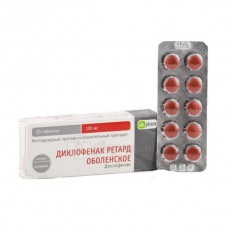Expiration date: 07/2026
Pharmacological action
Diclofenac is a nonsteroidal anti-inflammatory drug (NSAID). Anti-inflammatory, analgesic and antipyretic effect. Inhibits the COX enzyme in the cascade of arachidonic acid metabolism and disrupts the biosynthesis of prostaglandins.
Testimony
Inflammatory and degenerative inflammation activated forms of rheumatism:
- chronic polyarthritis,
- ankylosing spondylitis (Bechterew's disease),
- arthrosis,
- spondiloartrozy,
- neuritis and neuralgia, such as cervical syndrome, lumbago (lumbago), sciatica,
- acute attacks of gout.
- Rheumatic lesions of soft tissues.
- Painful swelling or inflammation after injury or surgical interventions.
- Non-rheumatic inflammatory pain conditions.
Contraindications
- pathological changes in the blood picture of unknown origin,
- peptic ulcer of stomach and duodenum,
- destructive, inflammatory bowel disease in the acute phase,
- pregnancy,
- lactation (should abandon breastfeeding),
- child and adolescence to 12 years (in/m),
- children up to age 6 years (tablets),
- hypersensitivity to acetylsalicylic acid or other NSAIDs (including "aspirin triad"),
- hypersensitivity to diclofenac and other components of the drug,
The drug Diclofenac is only possible under strict supervision of a physician after careful evaluation of the benefit/risk for the following conditions: congenital disorder of hematopoiesis (induced porphyria), systemic lupus erythematosus and other systemic diseases of connective tissue, the presence of complaints on the function of the digestive tract, or in cases of suspected ulcer of the stomach or duodenum 12, as well as in erosive-ulcerative lesions (ulcerative colitis, Crohn's disease), patients with previous renal disease and/or severe liver dysfunction, severe arterial hypertension and/or heart failure, elderly patients, immediately after surgery.
With great caution and only under the direct supervision of a physician, you can apply Diclofenac in patients with bronchial asthma, allergic rhinitis, polyps of the mucous membrane of the nasal cavity, as well as in chronic obstructive Airways disease and chronic infections of the respiratory tract in connection with the risk of asthma attack, angioedema or urticaria.


